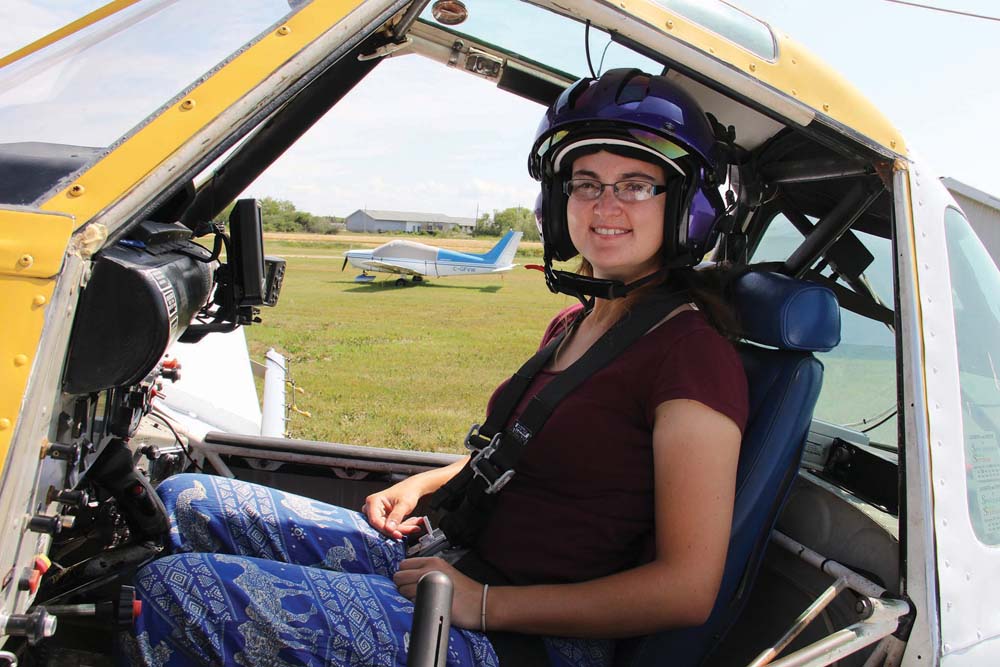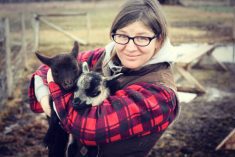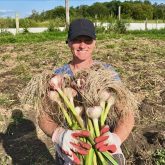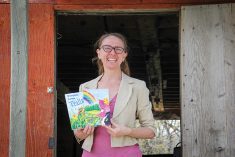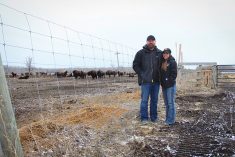Amy Johnson loves an early morning — cool, calm, no one around and perfect for flying.
“You’re just kind of in your own little bubble in the plane,” said Amy, 23. “You really feel like it’s just an extension of your body and the wings are your own wings… I get that feeling in this plane more than any other plane.
“You’re really in the same environment as a bird.”
Amy calls her white and yellow, 1976 Cessna AG Truck spray plane her baby. She laughed and pointed out hair ties hanging from a nob in the cramped cockpit, a sign that this is a woman’s plane. No one else flies it.
For two months of the year, she eats, sleeps and schedules her life around that plane, logging gruelling hours as an aerial applicator.
For the rest of the year, she flies a MedEvac plane.

The dream forever
Amy grew up on a grain and oilseed farm near Dugald, about 20 kilometres east of Winnipeg. Flying wasn’t in the family, exactly, but she said her dad, Vern Johnson, might have been a pilot in another life. When she was a kid, they’d park by the airport fence and watch the planes come in, or park on the road and watch crop dusters fly near the farm.
“I’ve always wanted to fly,” Amy said. “That’s my dream forever.”
At age nine or 10, Amy went to the Lyncrest airport northeast of Winnipeg for her first flight in a small plane as part of the Young Eagles aviation education program. After that, she returned year after year for flights.
Read Also

What I learned about Manitoba eggs
Manitoba-laid eggs provide good, locally produced nutrition while supporting local farmers and the Canadian agriculture industry.
Amy began flight lessons at age 16 and flew solo before she even had a driver’s licence. She got her private pilot licence at 18, commercial licence at 19, and instructor rating at 20. In 2016, she began working as an instructor.
She also studied business and aviation at Providence University College. She and her dad began a crop spraying business, starting with a ground sprayer. In 2017, they bought the plane.
For Amy, work as a MedEvac pilot began as a job that would allow her to take two months out of the year for her crop spraying business. She did a stint as a charter pilot then moved to MedEvac flights to northern Manitoba.
“We basically fly to any place that has a runway,” Amy said.

They’re two very different planes. On one hand, a Beechcraft King Air turbine with high-tech glass cockpit that can practically fly itself. On the other, a 40-year-old, piston-engine spray plane flown entirely by hand. But the skills translate and assist each other.
The spray plane takes off on grass, and the northern runways are mainly gravel. Amy is accustomed to landing and taking off on runways that change with the weather. She has to troubleshoot herself with no maintenance person to rescue her when her brakes freeze after taxiing through four inches of snow.
The spray plane has given her excellent hand-flying skills even when flying at the plane’s limit. The spray plane often flies with a heavy load, and executes tight turns that tax the plane. Amy said that some pilots get used to flying almost entirely by computer or flying a light plane, so if they accidentally hit the limits of the plane they’re in trouble.
An exhausting job
MedEvac flying also gives her a break from the farm. Amy said after two months of intense crop spraying she’s ready to do something else.
This year she set a personal record by flying 22 hours in two days. That was 22 hours pure flying time, not including time spent preparing or cleaning afterward.
“It’s an exhausting job,” Amy said. “There are so many things that go on inside the plane that I don’t think people realize the workload that’s involved in crop dusting.”
There’s paperwork, talking to customers, and cleaning. While in flight, she’s monitoring the plane for height and keeping an eye on any obstacles while maintaining a precise line across the field.
She also has to keep an eye on how much she has in the tank to spray, and if any nozzles are plugged — something she generally only has time to do while in a turn.
“It doesn’t happen spread out over the two months. It’s like you have a 10-day period where this crop is ready for fungicide and you fly like 10 hours a day for a couple of days,” Amy said. “It’s so important that you are ready and the plane is ready for that little burst.”
Amy said she feels a lot of pressure because she’s the only one who can fly the plane, and farmers are counting on her. This makes it tough to take breaks, something she said she’s had to learn how to do — sometimes, she just has to get out of the plane for an hour.
Still, Amy was quick to offer to take the plane up so the Co-operator could take pictures. She loves to fly, she explained. It was no bother.
“I feel very lucky that I get to be in an airplane that I own and so I fly it all the time. I’m the only one who flies it. I have everything the way I want it to be and it’s just like your own little safe spot.”







